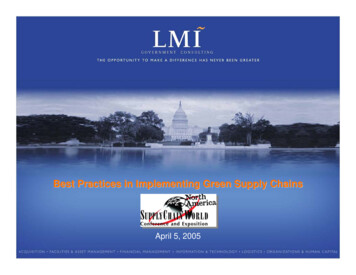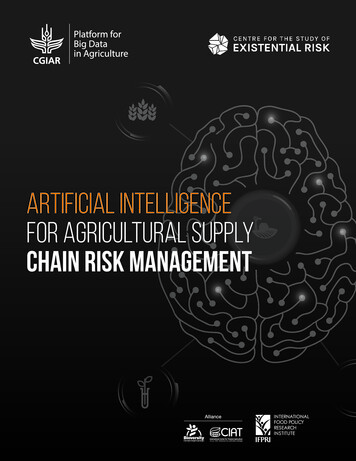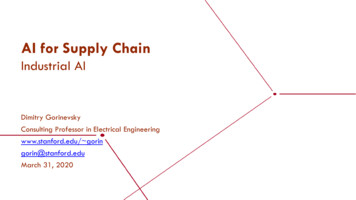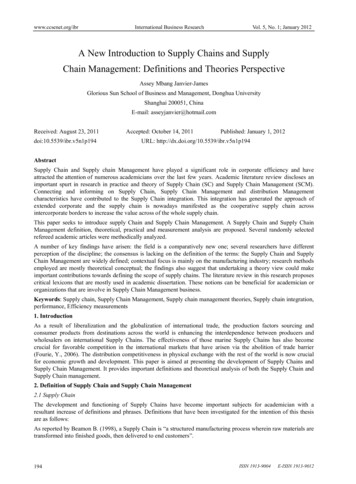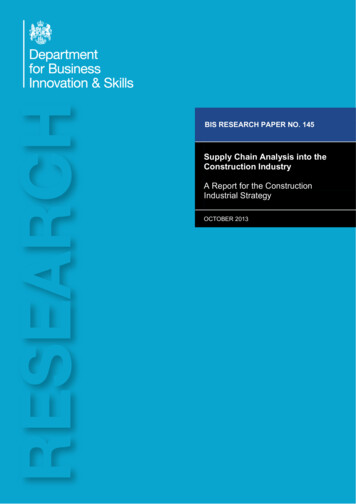
Transcription
BIS RESEARCH PAPER NO. 145Supply Chain Analysis into theConstruction IndustryA Report for the ConstructionIndustrial StrategyOCTOBER 2013
Supply Chain Analysis into the Construction Industry – A Report for the Construction Industrial StrategyThe views expressed in this report are the authors’ and do not necessarily reflect those of theDepartment for Business, Innovation and Skills.2
Supply Chain Analysis into the Construction Industry – A Report for the Construction Industrial StrategyContentsExecutive Summary. 4Acknowledgements . 181. Introduction . 192. Literature Review . 203. Supply chain structure . 354. Distribution of on-cost within the Supply Chain. 595. Structured interview analysis . 636. Analysis - key themes emerging from the supply chain survey . 937. Conclusions and summary answers to the project objectives . 104Annexes . 110
Supply Chain Analysis into the Construction Industry – A Report for the Construction Industrial StrategyExecutive SummaryThis report has been prepared by EC Harris LLP in support of the development of theIndustrial Strategy, Construction 2025: Strategy.The objectives of the study are: To identify areas where cost savings can be made in UK construction supply chainsand the barriers to achieving those savings. To identify elements of the UK construction supply chain that tend to be importedand understand why domestic firms are not competing. To recommend actions that Government and Industry can take to improvecompetitiveness of UK construction companies by overcoming barriers to theachievement of cost savings in construction supply chains.The methodology developed to meet the objectives of the study includes a literaturereview, a detailed study of supply chains made possible by direct support from maincontractors and their supply chains, and a series of structured interviews with members ofconstruction supply chains.Why the study is valuable at this point in the business cycleThis study is concerned with the structure of the UK construction industry and theimplications of this structure with regards to productivity, competitiveness and the futureattraction of the sector to new entrants.Research for the supply chain analysis review was undertaken in 2013 – five years afterthe commencement of an extended downturn in construction activity. In real terms,construction output in 2012 was 88.5% of levels recorded in 2008, and industry forecaster,the Construction Products Association, does not expect total output to start growing until2014 (2.2% in real terms) 1 .The ability of the industry to respond effectively to a recovery in demand without sufferingfrom capacity constraint or price inflation is of strategic concern to many sectors of the UKeconomy. With current low levels of investment affecting the UK’s future productivecapacity, the ability of the construction industry to respond to increased demand whilstremaining competitive and productive is a key issue. The study finds that constructionsupply chains are highly fragmented, and furthermore, that the level of fragmentationincreases in supply chains that are directly involved in the delivery of construction work onsite. The implications of a fragmented supply chain include relatively high transactioncosts, increased requirements for management input and coordination of activities on site,and fewer opportunities to drive out waste or reduce cost.1ONS, Output in the Construction Industry, June 2013, Table 2a. Construction Products Association, ConstructionIndustry Forecasts, Summer 2013.4
Supply Chain Analysis into the Construction Industry – A Report for the Construction Industrial StrategyThe study has also found evidence, through structured interviews, that challenging tradingconditions, very competitive bidding for work and use of tougher commercial terms relatedto payment and risk transfer is contributing to a reduction of levels of cohesion in theindustry. A number of respondents have indicated that many of the behavioural gainssecured following the implementation of the Latham and Egan Reports risk being diluted orlost altogether.Finally, the study has found evidence that supports the point of view that current pricinglevels are unsustainable, in that price reductions have been achieved through price cuttingrather than cost reduction. Examples include the practice of rebidding work within the subcontract supply chain, acceptance of low margins and inadequate pricing of risk. Theconsequences of unsustainable pricing can be seen in weakened balance sheets, whichreduce in turn the capacity of the supply chain to respond to an increase in demand.Having insight into the capability and capacity of the UK construction industry together withan understanding of its structure and the factors which have the greatest impact onperformance will be invaluable as the industry moves into recovery. This report providesevidence-based insight to address this need.The long term impact of supply chain performance initiatives –Literature ReviewThe literature review included in this study focuses mainly on three reports publishedbetween 1993 and 2008 which sought to drive improvement in the UK constructionindustry through change, and which identified the construction supply chain as an areawhich could contribute to this improvement in performance.The Latham Report, ‘Constructing the Team’, published in 1994 in the aftermath of anextended construction downturn, included a number of recommendations affecting supplychain behaviour and performance, in particular addressing issues of unfair conditions,payment and dispute resolution. Whilst implementation of the report may not havedelivered all recommendations, the Latham Report is generally considered to have made amajor contribution to the development of collaborative approaches to project delivery. Theteam’s research indicates a perception that these positive values have been underminedas a result of the downturn, and need repair and reinforcement.The ‘Egan Report’ published by the Construction Task Force in 1998 sought to improvethe quality and efficiency of UK Construction – identifying issues of widespreadunderachievement. The Task Force identified the supply chain as being critical toperformance improvement and identified commercial processes as a barrier to sustainedimprovement – advocating long term relationships based on clear measurement ofperformance and outcomes. The industry adopted many recommendations associatedwith ‘partnering’ when times were good but did not put in place all measures needed toassure the delivery of value across a full business cycle.The Wolstenholme Review, ‘Never Waste a Good Crisis’ published in 2008, concludedthat the construction industry had made little progress against Latham and Egan targetsand identified a range of actions needed to drive performance improvement – themes5
Supply Chain Analysis into the Construction Industry – A Report for the Construction Industrial Strategyincluding the business model, capability and delivery are highly relevant to the supplychain agenda.Results from the supply chain interviews presented in this report show that theimplementation of recommendations from these reports has had an impact on behaviourswithin the supply chain – although it is less clear whether clients have benefitted from thechange. There is also plenty of evidence that the industry has ‘returned to type’, becomingmore adversarial and less integrated, as a result of the current downturn.The structure of construction supply chainsA key element of this study is an analysis of Tier 1 and Tier 2 supply chains taken from asample of five projects. In the analysis, Main Contractors with a direct commercialrelationship with a client are termed Tier 1. Sub-contractors and suppliers with a directcontract with the Tier 1 main contractor are termed Tier 2. Sub-contractors and suppliersworking for sub-contractors are termed Tier 3. Tier 3 sub-contractors also employsuppliers and sub-contractors, so in many cases there will be a fourth or even fifth tierinvolved in construction delivery. The study was not able to obtain details of spendbeyond Tier 3.Four projects are representative of the work of national contractors and range in valuefrom 15 million to 25 million. A fifth project, with a value in the range of 1 million to 2million is representative of the work of smaller, regionally based contractors.The sample, described in the introduction to section 3, Supply Chain Structure, is basedon projects from the private and public sectors, featuring mixed use commercialdevelopments, academies and a hospital refurbishment. Projects have been sourced fromLondon and the regions. So far as is possible with a small sample, we have set out toidentify projects that are representative of wider trends affecting the non-residentialconstruction sector.The objective of the analysis is to build a better understanding of how supply chains arestructured, and whether project organisation and ways of working have an impact onproject performance. The analysis has three main components: An analysis of the structure and distribution of spend within the main contractors’Tier 2 supply chain, together with a small sample of sub-contractors’ Tier 3 supplychains. This analysis provides an insight into the complexity of supply chainmanagement and the degree of spend aggregation. This analysis is presented insection 3; An analysis of on-costs within the construction supply chain – identifying the costsof mark-ups for profit, overhead and risk, and considering whether any of thesecosts are duplicated. This analysis is set out in section 4; The results of a series of structured interviews with project participants, providingdeep insight into how supply chains operate, and what factors could driveperformance improvement. Commentary on the interviews is included in section 5.6
Supply Chain Analysis into the Construction Industry – A Report for the Construction Industrial StrategyThe detail of the analysis, together with a graphical analysis of the distribution of work inthe supply chain is presented for each project – enabling contrasting approaches to supplychain management and bundling of the work to be compared.Most construction work is delivered at the Tier 3 level or below – meaning that there aretwo tiers of management activity, procurement etc. above most construction activities.The implications of a complex supply chain for construction include issues of efficiencyassociated with the management of activities on-site rather than in a factory, and theopportunity costs associated with forming a new team for the delivery of each project – acommon occurrence with ‘conventional’ procurement of single projects based on acompetitive tender.The key findings of the analysis of supply chain structure can be summarised as follows: All projects in the sample feature a large number of Tier 2 suppliers (that is,specialist contractors such as cladding, building services or finishes contractors).To have 50 to 70 Tier 2 suppliers and sub-contractors is not uncommon; All projects involved a large number of low value transactions within each supplychain. For example we found that typically 25% of Tier 2 contracts on largecontracts with a value in excess of 15 million, were for values below 10,000; On all projects, between 50% and 75% of the total value of the work is accountedfor by a small number of major Tier 2 sub-contractors and the main contractor’s Tier1 site management team. Typically 4 or 5 sub-contractors are focused at Tier 2 onmajor packages associated with sub-structures, structures and envelope, andbuilding services. Although much of the value of construction work is aggregated inthis way, our study showed that actual delivery of these packages is undertaken bya disaggregated Tier 3 supply chain. As a result, coordination of activity on site hasa crucial role in influencing performance; For the delivery of complex sub-contracts, we found at least three tiers within thesupply chain, providing input into procurement, logistics and coordination, rangingfrom the main contractor (Tier 1) to the sub-sub contractor doing the work at Tier 3.Complex sub-contracts might involve elements of design, complex components andintegration with other sub-contracts, such as the structure or building services.Given the degree to which final delivery of the work is highly fragmented, the studyfound that there is a limited opportunity to consolidate the supply chain by removingcosts of Tier 2 intermediaries, due to their role in coordinating the work of installersat Tier 3 and below; Both Tier 1 and 2 contractors are involved in a large number of small transactionswith contractors, service suppliers and material suppliers doing work on their behalf.Evidence from both Tier 1 and 2 contractors suggests that the supply chainbecomes more fragmented for contractors involved in the actual delivery of work asopposed to its coordination. Analysis of the supply chain of a regional Tier 1contractor and a Tier 2 structures sub-contractor both, who are involved in the directdelivery of construction work, shows that these businesses have the most complexsupply chains;7
Supply Chain Analysis into the Construction Industry – A Report for the Construction Industrial Strategy Results of the analysis point to the important role that material producers, plant hirebusinesses and intermediaries such as builders merchants have in facilitating theready availability of construction products and services for small and low valuetransactions. These organisations operate at all tiers in the supply chain, from Tier2 and Tier 4 and below.The findings of the study suggest that the construction industry is not currently optimisedfor rationalisation of the supply chain. According to the review undertaken by the researchteam, the existing industry structure has affected previous initiatives to improveperformance. Furthermore, the design of these initiatives had been influenced by a lack ofappreciation of the structure and complexity of the supply chain. The conclusion is thatwhilst downward competitive pressure through the supply chain facilitates cost reduction,the current structure of the supply chain may not secure best value delivery through thecoordination of activities on site.Distribution of on-costs within the supply chainThe study includes an assessment of main contractor and sub-contractor on-costs. Oncosts cover profit margins, a project contribution to central overheads and allowances forrisk.Due to the complexity of a multi-layered supply chain, the research team havehypothesised that the duplication of multiple layers of profit, overhead and risk couldrepresent a source of non-value added cost and waste.The team has been able to compile an assessment of the total share of on-costs based onresults from the structured interviews.Our findings are that the level of on-costs is determined in part by competitive conditions –many contractors, for example, have put in place cost cutting programmes to reduceoverheads in the past 1-2 years, and profit margins are routinely adjusted as part of thebidding process. Reductions in additions for on-costs recovered by participants at alllevels in the supply chain have been a contributor to reduced prices paid by clients overthe past 4 to 5 years as a result of the recession. Many respondents commented thatcurrent levels of return from construction were unsustainable – particularly as allowancesfor project risk have also been cut. Falling profits reported by main contractors and subcontractors point to the consequences of high levels of competition and the ‘buying’ ofturnover through the submission of low bids.The evidence from the analysis suggests that typical on-cost additions in the supply chainare as follows: Main contractor (Tier 1) – 5 to 6% Integrator (Tier 2) – 6 to 7% Specialist contractor (Tier 2) – 12 to 13%8
Supply Chain Analysis into the Construction Industry – A Report for the Construction Industrial StrategyThe evidence of high overheads in some specialist sub-contracts may justify some delayering of the supply chain structure.A number of respondents, mostly specialist contractors, reported that they secured workon a zero per cent profit margin. Higher on-cost ranges tend to be associated with smallerpackages of work, together with a greater work content associated with product designand manufacture. For example, a specialist fabricator of architectural metalwork will needto recover higher on-costs than a decorating sub-contractor.Based on the results of the study, our assessment of the total proportion of a contract pricethat is attributable to supply chain profit margin and overhead margin is likely to be in therange of 18 to 20%. This assessment is not an average but takes into account thebalance of work content on a typical project.In the short term, and as the industry recovers from recession, these costs may increaseas the supply chain takes steps to improve margins to levels which are sustainable. Giventhe volume of coordination of activity on site, we see limited opportunity to reduce coststhrough the ‘dis-intermediation’ of the supply chain.The research team also set out to collect information on the level of pricing of risk withintenders. However, much less information was obtained and it is not possible to prepare anestimate for this on-cost. Results of the structured interviews indicate that risk is not beingfully priced in tender submissions.The pricing of risk represents a risk to both sides of the pricing equation. Current marketconditions permit the transfer of high levels of risk to the supply chain at a low cost. Asworkload increases, this balance is likely to shift, with suppliers pricing risk on a morecommercial basis – as well as seeking a change in the balance of allocation. Clients andmain contractors will need to manage this transition effectively to minimise the effect of riskpremium pricing on overall project costs.Drivers of high performance in the supply chainThrough structured interviews with 40 representatives of contractors, sub-contractors andsuppliers, we have isolated a series of enablers of high performance in the supply chain.These are highlighted in the figure below, which summarises the findings of the interviews,identifying the performance drivers which were mentioned most regularly by supply chainparticipants.The study tested six hypotheses which describe the determinants of effective supply chainperformance. The hypotheses are listed in the table below.9
Supply Chain Analysis into the Construction Industry – A Report for the Construction Industrial StrategyTable 1: Summary of the main hypothesis tested by the studyHypothesis testedHypothesis 1: FinancialarrangementsFinancial arrangements such as extended payment periodsintroduce additional cost and limit industry capacity by tying upcash flow, placing margins at risk and by limiting a business’sability to grow through increased workloadHypothesis 2: Selection ofthe Supply ChainSupply chain selection involves balancing competition andcooperation as means of developing best value solutions onbehalf of clients.Hypothesis 3: DesignmanagementDesign management has a crucial role in enabling improvedproject performance, by ensuring that design is complete andbuildable, by unlocking supplier contributions to designdevelopment and through effective change management.Hypothesis 4: Constructionsite managementEffectiveness of site management has a high impact on projectperformance as most of the integration and coordination of thesupply chain is undertaken by the site team.Hypothesis 5: PricedeterminationWork has to be priced realistically to drive effective projectperformance. The challenge for suppliers is whether the ‘realisticprice’ meets the affordability constraints of the client.Hypothesis 6: Supply chainintegrationGreater integration of the supply chain is an effective means ofreducing cost and eliminating waste.Theses hypotheses were tested trough structured interviews with Tier 1 and Tier 2 supplychains. An explanation of the methodology and a full description of the hypotheses are setout in section 5 of the report, Structured Interview Analysis.Insight obtained from the structured interviewsThe analysis published in the report describes in some detail the key findings from thestructured interviews, providing a wider commentary in connection with the specific issuesraised by respondents.The following summary of the results of the structured interviews identifies aspects ofsupply chain management that were thought to have the greatest impact on projectperformance:10
Supply Chain Analysis into the Construction Industry – A Report for the Construction Industrial Strategy Financial arrangements – certainty of payment; prompt paymento Prompt payment is described as building trust and encouraging flexibility inthe supply chain. Conversely, poor payment performance disincentivisesdiscretionary effort by the supply chain;o Sub-contractors state that payment performance is worsening and paymentsperiods are being extended as a result of current market conditions; Paymentdelays reduce contractors’ liquidity and in turn industry capacity and output. Supply chain selection: - repeat workload, early contractor engagemento Early contractor engagement is favoured because it enables greater supplychain involvement in solution development. Single stage tendering to designand build projects limits supply chain involvement in solution developmentand may not deliver best value;o Regular engagement of contractors in the context of settled relationships isseen by the supply chain as a positive because it facilitates effective sitemanagement and collaboration;o Very high levels of competition in supplier selection are seen to be having anegative effect on established supply chain relationships, which are at risk of‘breaking down’. Design management – early contractor engagement; sub-contractorinvolvement in design solutions; incentive to contributeo Incomplete design, design change and late variations are seen as a cause ofsignificant waste; causing disruption to progress of the work, reducingefficiency and increasing site management workload. Barriers to theimplementation of change are not high enough to discourage high levels ofchange orders;o Reduced levels of professional fees have reduced available design resource,which may in turn have affected the quality and reliability of initial designs;o Subcontractor engagement in detailed design supports improved projectperformance.o Management – good communication; well managed programme; good teamrelationshipso Good on-site communication is seen as the most critical driver ofperformance, emphasising the importance of a manager’s ability to combineknowledge, experience and soft skills;o Supply chain members consider that there is a high dependence on theability of the project manager to drive high performance. Effective application11
Supply Chain Analysis into the Construction Industry – A Report for the Construction Industrial Strategyof soft skills is viewed as being critical in driving high levels of projectperformance;o Good programming is seen as being critical to coordinate the activities ofmultiple suppliers and to accommodate the results of change;o Extended lead-in times on projects are valued as they provide more time tobuild good project team relationships. Price determination – realistic pricingo Realistic’ price levels are seen by project participants to be a positivecontributor to project performance;o Under pricing is described as having a negative effect on projectperformance;o Eagerness to work with a client and overall levels of demand were describedas the strongest determinants of the overall level of pricing relative to inputcosts. Supply chain integration – more effective coordination and use of projectresourceso There was evidence from the sample of some vertical integration, with maincontractors taking on the building services integrator role;o The team noted growing cynicism amongst sub-contractors with regards tosupply chain integration activities. For example, there was little spontaneousmention of Building Information Modelling (BIM) and no mention of adoptionon case study projects.None of these performance drivers identified through the structured interview process areparticularly innovative or new. However, the message from participants was that theindustry did not manage the basics as well as it could, and that the supply chain did notperform as well as it could as a result.12
Supply Chain Analysis into the Construction Industry – A Report for the Construction Industrial StrategyKey themes emerging from the supply chain surveyThe analysis has also identified five cross-cutting themes which illustrate how theperformance of the supply chain is affected by the interaction of the issues raised in thestructured interviews.The themes and key issues described in an analysis of the supply chain survey are asfollows: Effect of behaviours and soft skills – Project Managers (PM) have a key role inconnection with project performanceo Behavioural issues within project teams were identified as a very importantpositive improvement driver. Interviewees identified the contractor’s projectmanager as having a key role in positively influencing these behaviours;o Due to the complexity of the supply chain, a high level of informalcollaboration, the need to accommodate change and low margins – theresearch demonstrates that effective site management has a key role indelivering successful outcomes for clients and constructors;o Feedback from the supply chain suggests that investment in theimprovement of site management skills will help to drive better performance. Management of change – the low cost of change comes at a price for theindustryo Construction has developed processes to accommodate change in designand construction. However, by comparison with other industries such as IT, itcan be argued that construction accommodates change too readily and attoo low a cost at the point of change;o Evidence from the study suggests that the volume of change is high, comesfrom too many sources, and can be highly detrimental to projectperformance;o The ability to introduce change is the industry norm, but is seen by thesupply chain as a source of waste, a cause of uncertainty and a catalyst forgreater friction between trades. Many firms stated that the cost ofimplementing change outweighed any income premium they might receiveas a result of the change;o Change is a major source of waste. The ability to introduce changes duringdesign and construction is desirable, but the industry’s presumption shouldbe in support of managed change control in support of better decisionmaking. Certainty of outcome and risk transfer – costs of risk transfer will be built intofuture project costs13
Supply Chain Analysis into the Construction Industry – A Report for the Construction Industrial Strategyo Construction involves high levels of risk due to a combination of ‘one-off’design and construction, site-based working, fixed-price contracting andsupply chain fragmentation;o Risks transferred typically include compliance with planning, regulatorycompliance, building performance, sustainability standards, teamperformance, programme, and cost and so on;o Risk transfer mechanisms generally work well for the clients. However, theallocation and management of actual risk is often erratic and inefficient,increasing uncertainty, and resulting in inefficient working, waste andunnecessary cost;o Tough market conditions have increased the level of risk held by the supplychain. However, the progressive transfer of risk from client throughcontractor to the supply chain may not result in optimal outcomes;o The effectiveness of the management of this transfer of risk into the supplychain affects overall cost levels in the industry, as well as productivity andprofitability. Over time, the costs associated with risk transfer will be builtinto the cost of work, through the proper pricing of risks in tenders, potentiallyincreasing project cost. Effect of demand and market conditions – a low entry price may result inhigher overall costso Evidence from supply chain interviews clearly shows that low levels ofdemand and continued tough trading conditions have a negative effect onfirms, relationships and project performance;o Firms appear to be hoping that the market will return to conditions seen priorto 2008. There was little evidence either of innovative or adaptive responsesto current market conditions, or of a belief that current conditions and pricelevels represented a new baseline;o This optimism, which is not supported by workload forecasts, weakens theindustry’s current focus on cost and waste reduction initiatives that areessential to sustain long-term competitiveness;o Interviews provide evidence of a shift in b
Tier 2 supply chain, together with a small sample of sub-contractors' Tier 3 supply chains. This analysis provides an insight into the complexity of supply chain management and the degree of spend aggregation. This analysis is presented in section 3; An analysis of on-costs within the construction supply chain - identifying the costs






